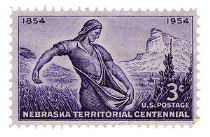Extension, Cooperative

Nebraska Agricultural Experiment Station: Historical Research Bulletins
Date of this Version
10-1945
Document Type
Article
Citation
Hathaway, I.L., Davis, H.P. and Keim, F.D. (1945) Carotene content of native Nebraska grasses (Research Bulletin: Bulletin of the Agricultural Experiment Station of Nebraska No. 140)
Abstract
The carotene content of twenty-four grasses native to Nebraska were determined at approximately monthly intervals from June to November. While the carotene concentration of most of the grasses was moderately high during the growing season, it declined to a rather low point by late November. With the exception of Switchgrass, Hairy Grama, Little Bluestem and Prairie Dropseed, all of the grasses contained enough carotene to supply the needs of range cattle until late November. However, only eighteen of the grasses still contained enough carotene by the latter part of September to furnish the carotene required by dairy cows. Even as early as July the Northern reedgrass, Buffalo grass, Bluejoint and Lovegrass were unsatisfactory as a source of carotene for dairy cows. While the carotene values observed during the periods of greatest concentration varied from 511.6 ppm (Sandhill bluestem) to 122.6 ppm (Northern reedgrass), these values ranged from 60.7 ppm (June grass) to 1.6 ppm (Little bluestem) during the periods of lowest concentration.
Included in
Agriculture Commons, Agronomy and Crop Sciences Commons, Dairy Science Commons, Meat Science Commons


Comments
ISSN 0097-1471